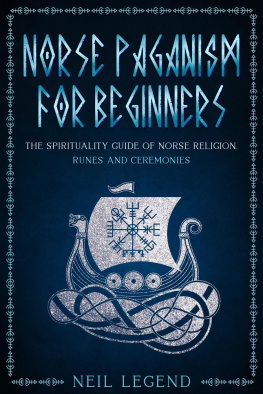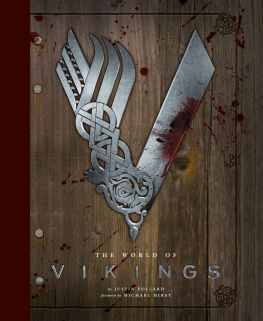Martin J Dougherty - Vikings: A History of the Norse People
Here you can read online Martin J Dougherty - Vikings: A History of the Norse People full text of the book (entire story) in english for free. Download pdf and epub, get meaning, cover and reviews about this ebook. City: S.l, year: 2017, publisher: Amber Books Ltd, genre: History. Description of the work, (preface) as well as reviews are available. Best literature library LitArk.com created for fans of good reading and offers a wide selection of genres:
Romance novel
Science fiction
Adventure
Detective
Science
History
Home and family
Prose
Art
Politics
Computer
Non-fiction
Religion
Business
Children
Humor
Choose a favorite category and find really read worthwhile books. Enjoy immersion in the world of imagination, feel the emotions of the characters or learn something new for yourself, make an fascinating discovery.

- Book:Vikings: A History of the Norse People
- Author:
- Publisher:Amber Books Ltd
- Genre:
- Year:2017
- City:S.l
- Rating:5 / 5
- Favourites:Add to favourites
- Your mark:
- 100
- 1
- 2
- 3
- 4
- 5
Vikings: A History of the Norse People: summary, description and annotation
We offer to read an annotation, description, summary or preface (depends on what the author of the book "Vikings: A History of the Norse People" wrote himself). If you haven't found the necessary information about the book — write in the comments, we will try to find it.
Vikings: A History of the Norse People — read online for free the complete book (whole text) full work
Below is the text of the book, divided by pages. System saving the place of the last page read, allows you to conveniently read the book "Vikings: A History of the Norse People" online for free, without having to search again every time where you left off. Put a bookmark, and you can go to the page where you finished reading at any time.
Font size:
Interval:
Bookmark:
VIKINGS
A HISTORY OF THE NORSE PEOPLE
MARTIN J. DOUGHERTY

This digital edition first published in 2014
Published by
Amber Books Ltd
7477 White Lion Street
London N1 9PF
United Kingdom
Website: www.amberbooks.co.uk
Appstore: itunes.com/apps/amberbooksltd
Facebook: www.facebook.com/amberbooks
Twitter: @amberbooks
Copyright 2014 Amber Books Ltd
ISBN: 978-1-78274-082-7
Picture Credits
Alamy, Amber Books, Bridgeman Art Library, Corbis, Dorling Kindersley,Dreamstime, Arni Ein, Mary Evans, FLPA, Fotolia, Getty Images, Istockphoto,Photos.com, Shutterstock, TopFoto.
All rights reserved. With the exception of quoting brief passages for the purpose of review no part of this publication may be reproduced without prior written permission from the publisher. The information in this book is true and complete to the best of our knowledge.All recommendations are made without any guarantee on the part of the author or publisher, who also disclaim any liability incurred in connection with the use of this data or specific details.

www.amberbooks.co.uk
Chapter One
Origins of the Vikings
Chapter Two
The Old Norse Religion
Chapter Three
Viking Law and Social Order
Chapter Four
Viking Society
Chapter Five
The Early Raids
Chapter Six
Viking Weapons and Combat
Chapter Seven
Explorations, Settlement and Trade
Chapter Eight
The Viking Kingdoms
Chapter Nine
The End of the Viking Age
Chapter Ten
The Legacy of the Vikings
F ew peoples or groups have ever exerted such an influence on popular culture as the Vikings. They have given us everything from the foundation of modern cities to comic-book superheroes. Their explorations and raids put islands and even continents on the map. Their depredations are, of course, legendary.
And yet most of what has passed into popular culture about the Vikings is just that: legend. For the Vikings, at least as they are popularly depicted sea-raiders in horned helmets, drinking mead from skull goblets and longing to die gloriously in battle never actually existed.
Even the famous quote From the fury of the Northmen, Good Lord, deliver us is quite possibly a myth. It has been attributed to many religious figures of the time, and it is certain that many people prayed for exactly that. But the true original source is hard to find; there may not even be one. It may be that the most common quote associated with the Vikings, the phrase that more than anything else sums up their deeds, is itself a modern invention.

More than anything else, the longship is a symbol of the Vikings. In these small but seaworthy vessels they fought, raided, traded and pushed back the boundaries of the known world.
The reality of the people who have become known as the Vikings is rather more complex than the popular version; at once far more mundane and in many ways even more incredible than the well-known tales of bloodthirsty raiders and grim warriors. These were the people who voyaged across the hostile North Atlantic Ocean in open-topped ships, who carried their vessels overland to reach the Russian rivers, and sailed down them to find new trade partners or sources of plunder. They were explorers, settlers and traders as well as warriors, and their legacy helped shape the modern world.

Much of what we know about the Vikings comes from burial sites like this one at Aalborg in Denmark. Finds must be correctly interpreted if they are to increase our understanding of the Viking culture.
What we know about the Vikings comes from many sources, none of them completely reliable. Conventional archaeology has unearthed artefacts, burial sites and settlements, allowing us to study what the Vikings left behind but only the relatively small amount of material that is well preserved. We can make inferences and take educated guesses as to the significance or even function of an item, but we cannot be certain. Some known facts are extrapolated from relatively obscure sources, such as the imprint of long-decayed cloth on jewellery found in a grave. Although highly intelligent experts made these extrapolations, they can never be more than a best guess.
Experimental archaeology has allowed us to learn about how the Vikings built their homes and ships, and how they fought. While some re-enactors do no more than play at being movie Vikings, many are dedicated researchers who have done good work in reconstructing what might have been. In terms of fighting with an axe or building a ship, chances are that a person working under similar conditions with the same materials and tools will take a similar approach whatever century he is from.

To some, Viking re-enactments are a fun game of make-believe. To others they are an opportunity for hands-on research into every aspect of the Viking way of life.
We can also learn a lot from historical writings, but these are inevitably biased. We owe much of what was written about the Vikings to Churchmen or the inhabitants of kingdoms that had felt the fury of the Norsemen. Even without intentional bias, their viewpoint would be coloured by the fact that they themselves were not Vikings and did not understand the Viking psyche or way of life. In many cases they were writing from observation of only one segment of Viking society usually warriors, raiders or trading parties whose behaviour in foreign lands might be quite different to their home life.
One of the most direct sources on the Vikings is the body of poetry and oral history that forms the sagas. However, these are heroic tales told over and over for years until they were finally written down centuries after the events they depict. In many cases the events of a saga can be tied to historical evidence or corroborated by other means, but ultimately the sagas are fictionalized adventures that may be no more accurate than the average historical novel.
When taken all together, these sources allow us to build a picture of who the Vikings were and what they did and, more importantly, why. The popular image of wanton destruction and carnage perpetrated by mobs of hairy, filthy men is not in all ways unwarranted. The Vikings did pillage and they did destroy places of value and beauty. Their raids brought misery to their victims and turmoil to many regions. They also offended people who were in a position to write history and have it remembered.
The Christian Church feared and hated the Vikings for their destruction of monasteries; prominent clerics made sure that the deeds of the raiders were recorded and made known. Their outrage was justified and understandable, but it was only one side of the story. The Vikings, in short, have had a lot of bad press as a result of their choice of targets, and for years much of what was known about them was based on what amounts to hostile propaganda.
It is true that the Vikings were a violent people. Strength and fighting ability were vital to the survival of the trader or explorer, and a man had to defend his home, family and community from those who would take all he had.
Next pageFont size:
Interval:
Bookmark:
Similar books «Vikings: A History of the Norse People»
Look at similar books to Vikings: A History of the Norse People. We have selected literature similar in name and meaning in the hope of providing readers with more options to find new, interesting, not yet read works.
Discussion, reviews of the book Vikings: A History of the Norse People and just readers' own opinions. Leave your comments, write what you think about the work, its meaning or the main characters. Specify what exactly you liked and what you didn't like, and why you think so.






